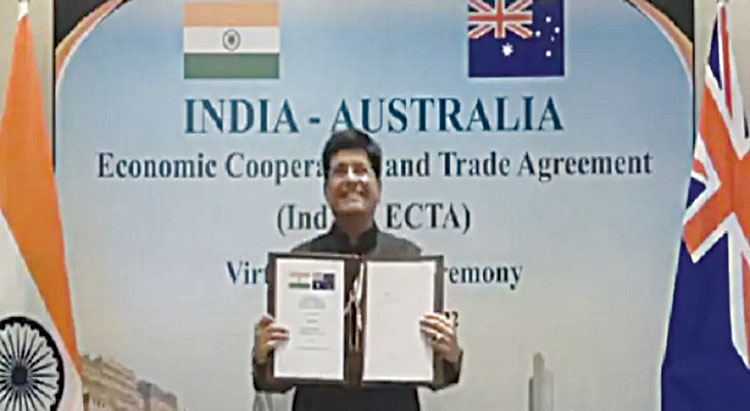New Delhi, Apr 3 (Bureau) Seeking to boost trade and enhance market access for businesses from both sides, India and Australia on Saturday signed India-Australia Economic Cooperation and Trade Agreement (IndAus ECTA). The pact was signed by Commerce Minister Piyush Goyal and Minister for Trade, Tourism and Investment, Government of Australia, Dan Tehan in a virtual ceremony in the presence of the Prime Minister Narendra Modi and Prime Minister of Australia, Scott Morrison. As the two countries signed the bilateral agreement to remove trade barriers and ensure duty-free access for bulk of the items, Commerce and Industry Minister Piyush Goyal said that the pact would help bilateral trade reach $45-50 billion in next five years from $27 billion at present. He noted that the pact is particularly important for India as it is a first agreement with a large developed economy in the last decade.
Further, he said that it opens up a lot of opportunities across various sectors including textiles, pharma, hospitality, gems and jewellery and IT besides creating huge employment in both countries. “They (Australia) have provided 100% access to all Indian goods, almost 97% of our trade as soon as this agreement comes into force after the processes are completed on both ends and the rest over five years. India has also provided significant market access of, I believe, 85-90% of our trade and a large part of it is immediately as we enter into force. We have also looked at areas of interest between both countries and ensured that market access is provided in those areas of interest. Simultaneously, both countries have been very fair and reasonable in terms of local sensitivity on issues related to trade, related to services and have truly respected each other’s sensitivity and therefore I believe this is a win-win agreement between both countries,” Goyal said. The Minister said that the agreement would also give a leg-up to the hospitality sector in India and Australia and also help skilled young boys and girls to contribute to each other’s economies. “We have a number of students who are studying in Australia, working in Australia. This will send a very strong signal to Indian students and diasporas in Australia. It will also create new opportunities.
..As per initial estimate we expect at least 1 million job creation in India in the next 4-5 years. A number of new opportunities for chefs and yoga instructors in years to come. Post studies work visas are also a part of this agreement,” Goyal said. Australia and India are important trading partners. Major Indian exports to Australia are petroleum products, medicines, polished diamonds, gold jewellery, apparels etc, while key Australian exports to India include coal, LNG, alumina and non-monetary gold. In services, major Indian exports relate to travel, telecom and computer, government and financial services, while Australian services exports were principally in education and personal related travel. In 2020, India was Australia’s seventh-largest trading partner and sixth largest export destination, driven by coal and international education. Ajay Sahai, Director General & CEO at Federation of Indian Export Organisations (FIEO) hailed the India-Australia trade agreement.
“It’s good agreement which will help us in both goods and services. In the goods sector, we are likely to get better market access and better share in engineering goods, apparel, gems and jewellery, leather, oilseed, plastic and services including travel and tourism,” he noted. Sahai said that government seems to have revisited the entire FTA (free trade agreement) strategy and now they are focussing more on complementary economies. “The problem with our earlier FTAs was that the FTAs were with countries which were very strong in manufacturing and that’s why we have landed in a situation where our imports growth outpaced exports growth. That has led to some criticism also,” the FIEO Director General said. “Now we are working with complementary economies. UAE has been one, now we are having one with Australia. Canada is in pipeline. Very soon, we will have FTAs with GCC (Gulf Cooperation Council) and EU. So, FTAs with complementary economies which are our major markets is a big plus for all of us. Negotiating with them is relatively easier. If they are not complementary economies then you may be producing the same, they may be producing the same. Giving market access at the cost of domestic industry is a little tricky. Since we represent export body we are all for FTAs and better market access,” he added. Commenting on the pact, industry body CII said that signing of ECTA with Australia would prove to be a big game changer for India’s exports and manufacturing competitiveness.
“Getting zero duty access on almost 97% of value of India’s exports immediately is a remarkable gain for Indian industry. As Australia would be a complete zero duty market for Indian exports in the next five years, industry would strategise well to access Australian markets,” said Chandrajit Banerjee, DG, CII. The trade agreement between India and Australia covers almost all the tariff lines dealt in by India and Australia respectively. An official statement issued by Commerce Ministry said that India will benefit from preferential market access provided by Australia on 100% of its tariff lines which include all the labour-intensive sectors of export interest to India such as Gems and Jewellery, Textiles, leather, footwear, furniture, food, and agricultural products, engineering products, medical devices, and Automobiles. “On the other hand, India will be offering preferential access to Australia on over 70% of its tariff lines, including lines of export interest to Australia which are primarily raw materials and intermediaries such as coal, mineral ores and wines etc,” it said.

